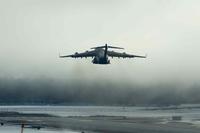A couple weeks ago I had the great fortune to participate in a two day blogger seminar with the folks from WL Gore -- you know, the company that makes the waterproof/breathable membrane used in the best foul weather gear.
While it was in illuminating look under the curtain of a normally secretive company -- with tours of their production floor and rainwear test lab in Elkton, Md., and their nearby glove and boot lab -- my primary emphasis was on the development and testing of the only Gore camo patterns the company will own up to.
While I tried to pry information out of their military products PR person about what role Gore might be playing in the camo market, I was monumentally unsuccessful. But I did get a lot of great info on a ground-breaking pattern the company developed with some of the best minds in the military camouflage science world.
The two patterns, Optifade Open Country (developed in 2008) and Optifade Forest (released this year) take a radical departure from what most people think of in camo. Both patterns are used exclusively for hunting -- the Open Country pattern was developed primarily for hunting elk, antelope, bighorn sheep and other horned game in the mountain environment; the Forest pattern was released this year for the tree stand deer hunter. But each takes the scientific approach on how such animals see color and contrast.
Gore provided a full hunting setup of Optifade Forest gear from their sister company Sitka for me to try out during the season.
Most commercial camo patterns for hunting are so-called "mimicry" patterns -- they essentially replicate a photo snapshot of the background and try to match it exactly. That's fine as long as you don't move and the background matched perfectly. But in 99.9 percent of situations you're hunting in, that's not possible.
I got a good lesson in the science of camouflage and, more importantly for our discussions here, from the man behind the innovation of Optifade, retired Army Lt. Col. Tim O'Neil. Tim is known as the "Father of Digital Camouflage" and worked closely with Gore, the clothing manufacturer Sitka and Guy Cramer, the man who runs Hyperstealth, a Canadian camo innovator.
%embed1%
Tim is a consultant with Gore and continues to work with the company on further camo designs for the civilian market (rumor has it the company is working on a pattern designed to fool a bird's eyesight to be used for turkey and waterfowl hunters). But he's also got a close relationship with PEO Soldier and is working as a consultant on the Phase IV camo effort in making sure the Army has good test methodology to evaluate contestants.
I include a video of a brief he gave at the Gore headquarters on Optifade and the advantages of digital camo over other methods. It's something we should think about as the Army begins to examine camo patterns during the Phase IV program. MultiCam has some digital aspects, but is nowhere near as "digital" as other potential contenders.
I will say that, while weird looking and radically different from anything I've hunted in before, the Optifade Forest worked well. I had one big buck bust me at about 10 yards, but it could have been from the contrast of my uncovered face (we were bow hunting at a Gore-sponsored outing in eastern Maryland). But I did end up harvesting a good doe who moseyed by me with about three others, glancing around and completely unaware of my presence.
While it's rumored that Gore will not offer Optifade for any military camo competition, it'll be interesting to see if they attend the industry day next week. If their efforts on the science behind Optifade inform the engineering of a military camo for the Army, be prepared for some very intriguing stuff from them.








